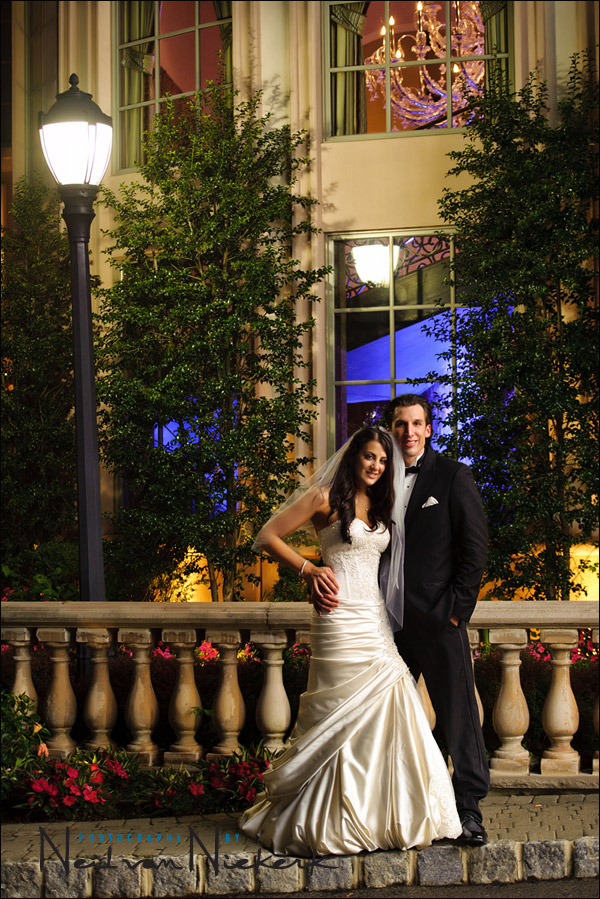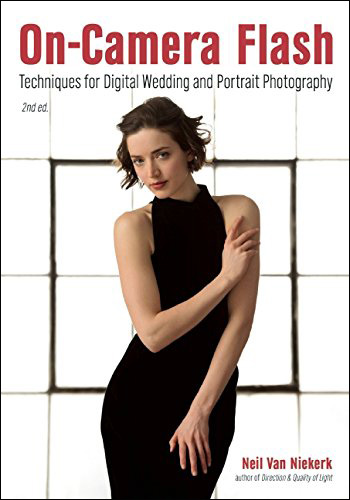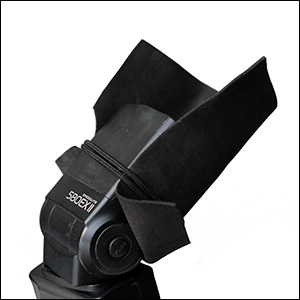
Using on-camera bounce flash outdoors
With wedding photography, when doing the night-time romantic portraits of the couple, the pressure is usually on. The only opportunity to whisk the couple away for a few minutes, is during dinner time, when the party is at a lull. The pressure is on because you have even less time than you had during the earlier part of the day, and you also don’t want to lose the attention of your couple who wants to get back to their guests at the reception.
I usually scout a few places before-hand, getting a clear idea of what I want. When setting out with the couple, I rely on bounce flash and on video light. There is rarely time for carrying around a soft-box. You need to move fast, set up fast … and still come up with the goods.
With this wedding from the past weekend, I wanted to capture two specific portraits of the couple with the outside of the venue as a backdrop. I would normally have used video light here, but I had the idea that I wanted the compression from a longer lens … the 70-200mm f2.8 … and then the person holding the video light would be in shot. So the solution was to get flash in there. Where we were working outside there, I fortunately had part of the building to bounce my flash off.
On-Camera Flash Photography – revised edition
This book is explains a cohesive and thorough approach to getting the best from your on-camera speedlight.
Particular care was taken to present it all with a logical flow that will help any photographer attain a better understanding of flash photography.
You can either purchase a copy via Amazon USA and Amazon UK, or can be ordered through Barnes & Nobles and other bookstores. The book is also available on the Apple iBook Store, as well as Amazon Kindle. Also check out the Amazon Kindle store.
Learn more about how the cover image was shot.

Here is a quick grab-shot with my camera which had the 24-70mm f2.8 on, so that you can see what I bounced my flash off – that part of the building over where the guests arrive.
Because I had to bounce my flash partly forward, towards the couple, I had to flag my flash. Black Foamie Thing to the rescue! As always, the idea with using the BFT to flag my flash, is to block any flash falling directly on my couple. This way I can get soft indirect light, similar to using an off-camera softbox. Of course, I had to be at fairly extreme settings on my camera to make this work in this case.
Camera and flash settings & photo gear used (or equivalents)
camera settings: 1/60 @ f2.8 @ 1600 ISO; TTL flash
The lens was zoomed to 70mm for this specific image.
- Nikon D3
- Nikon 70-200mm f2.8 AF-S VR II / Canon EF 70-200mm f/2.8L IS II
- Nikon SB-910 Speedlight / Canon 600EX-RT Speedlite
- a BFT (black foamie thing)
On-camera flash modifier – the black foamie thing
The BFT is held in position by two hair bands (Amazon), and the BFT is usually placed on the under-side of the flash-head.
The linked articles will give clearer instruction, especially the video clip on using the black foamie thing.
Summary
Oh, about those sloping verticals – that light pole is actually skew! And the kerb does slope outward like that.
Working fast like this, with a flexible idea of what is possible in bouncing on-camera flash, I was able to get an image which really looks good. Ultimately though, on-camera bounce flash is just one part of any photographer’s lighting arsenal.


Neil – You have become my photographic guru! I have to admit to checking out your site at least once a day – sometimes several times more. I’ve been very interested in the constant reference to the Black Foamy Thing and this current article really does it for me. I can suddenly really see just what the benefit is to using that little ‘device’. Pure Magic!
I shot a roll of film this weekend past (in Sydney, Australia)and used the ambient light/flash exposure techniques that you so frequently espouse, and I was very happy with the results. Hope you head this way soon – I sense that you already have a substantial following here.
So, photographic messiah, I thank you for your inspiration and teaching and hope that your continue to prosper.
Regards
Roy
Neil, great info !!
I am just amazed of the power of that speedlite.
Do you think that would be possible with a 430EX II ?
Very nice picture, and a great idea to bounch the light of the big white wall :)
Every time I use TTL at night with low ambient light, my histogram is skewed to the left (left to middle of the histogram). Is that how your shots turn out?
The image ends up fine overall, but I’ve lost a lot of data in the image.
Hi Neil,
The flash must be the dominant light source for the subject so is this a case of ‘dragging the shutter’ to let the background ambient register nicely and then letting TTL flash do the rest? Aperture and ISO settings to get best reach out of the flash gun given what you were bouncing off?
Thanks for all the great articles,
Scott
Great location– looks like a movie or theatrical set. I remember the couple’s engagement photos.
Neil,You never cease to amaze. Great image and capture.
Neil,
Great photograph and fabulous use of the wall surface to the right. I was curious why you used a smaller aperture to get greater depth of field. A little surprised you didn’t choose a softer background with your f/2.8 lens.
Thanks,
Bob
Neil, Very nice! thx for sharing that idea.
Hi Neil, since reading your bounced flash + BFT, I’ve been bouncing off everything, even outside: cars, trees, other people.
I’d imagine to pull off your shot, you needed a fairly high ISO for the flash to register, especially with the wall so far away.
I’ve tried something similar during a sunset portrait with some problems: to underexpose and saturate the sky, I needed a low ISO. After bouncing the flash at a nearby wall, it was difficult to get the subject to be exposed properly – probably because the ISO was too low to “register” the flash.. any tips on these situations? Thanks!
Hello Neil,
I have a great doubt.
In this photo you said that to achieve the shot you would need a very high ISO (1600) to get the flash on TTL married couple.
If I remember correctly, the FLASH TTL is not ‘affected by ISO and shutter opening.
Iso opening distance and power of the flash manual flash only influence.
In TTL flash shutter speed and aperture and ISO affect ONLY the background … and ‘correct?
So to increase the power of a TTL flash I just have to act on comprnsazione Ev (+1, +2, +3).
Why ‘increase ISO to increase the power of the flash TTL when the flash output in TTL is controlled only with a positive EV??
Thanks Neil you’re always the best source of my inspiration and constant.
Edy trigona Genoa Italy
Neil, Wonderful post! I must say your new book “Off Camera Flash” is the one of best photo books I have ever read!
Cheers,
John
Mornin’. Since this is vertical image and the light is coming from camera right, did you basically shoot with the camera in reverse? Otherwise the flash would’ve been aimed to the left. I’ve never tried that before. I see more and different practice in my future if that’s how you did it.
I know it’s probably more case-specific than anything, but when using TTL flash as the main source when bouncing it, are you generally using it around +2, or maybe higher? (This photo, e.g.)
I almost always use manual flash, but I’m trying to make clear to myself when TTL makes more sense, and how to arrive at a +/- setting intuitively based on a particular situation.
And secondly, when dragging the shutter and using flash as your main light source, how much do you “let up” on the “rule” of (roughly) 1/focal length as your shutter speed? Especially during reception photos, when people are moving a lot.
Hopefully my questions make some semblance of sense, any thoughts appreciated. Thanks Neil!
I am always inspired by what you share, this is no exception. Your examples help SO much.
It’s better and better, your tehnique and your images inspire all of us.
This is a stellar example of the technique. I’ve been able to bounce the flash off of outdoor structures too, but rarely do you get something so big and white as the structure you had here. The photo looks great.
Hi Neil, nice post!
Did you zoom your flash? Do you remember how much?
thanks
Hi Neil,
I am impressed by the focus behind the couple. I thought it would have been softer at f/2.8. That is all I meant to say. Thanks for clarifying. The photograph is something we would all like to achieve. Your help is appreciated.
Bob
Hi Neil — this is my first note here. I’m just an amateur who loves portraits now and then when I get the chance. I found your site a few months ago after a frantic search on the Internet — because I had to use flash for the first time at an indoor event (and also purchased your book). Just want to say that you’ve been an amazing teacher. Thanks for so generously sharing your knowledge!
how much flash comp did u use??
Hi!
I’m a long time reader, but here’s my first note :)
I’m curious about the pull back shot where you included the white wall where you bounced your flash. I noticed that the couple were still underexposed.
Did you increase the FEC for the main photo of the couple?
Or did you intentionally darken the couple in post to emphasize the wall (2nd image)?
Thanks! And I really love your blog!
Neil the genius! You are master of speedlight usage man! you simply rock!
Just phenomenal. It really is world class stuff you’re giving us here, Neil. Thanks for this one. Tied it all together for me rather abruptly.
Brad
Hi Neil
Have been reading your tangents for a few months and have been super pumped at all the great info.
Thanks,
I do have a quick question from a rookie :)
How did you handle the white balance in this shoot?
Ben
Hi Neil,
Great shot in a less than idea location! A couple of questions. Firstly, in some previous posts, you’ve mentioned Quantum flashes. Could you see yourself using a Quantum flash on a bracket to squeeze out lower ISO? I’ve been looking into a Quantum setup and wondered how that would affect my workflow.
Secondly, what do you look out for in order to make sure the groom doesn’t cast a shadow on the bride?
Thanks,
Ed
great shot an thanks for the information!
if you keep hammering this into my head it may stick someday. i forget about some/allot of the bounce possibilitys out there.
thanks again.
Thanks again for some great advice. I’m going to start playing with my ISO more to see how much more use I can get out of my 580.
The white wall used for bounce now becomes a MAJOR distraction in a photo that is about the bride and groom. Bounce flash is fine as long as the surface you are bouncing off does not overwhelm the actual photo itself.
This is a great solution to lighting, and I like the overall look, but am surprised no one has mentioned the dark shadow cast on the groom’s face, with his right eye almost completely in shadow, which most wedding clients would find objectionable.Turning him more towards your light source would minimize that.
Neil, how would you shoot a house & backyard party with on-camera? Balanced ambient with flash mounted CTO gel indoors bounced off wherever I want to direct the light (ceilings/walls/corners) is what I would guess might work ok for inside – but what about outside, just say there is no roof and no walls or windows to bounce off? What do you when you can’t actually angle the light towards anything other than the subject? Without going off-camera.
Thanks Neil, love your guides!